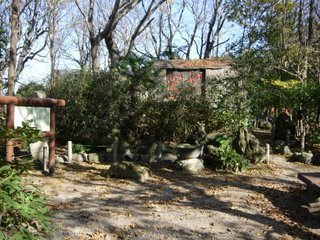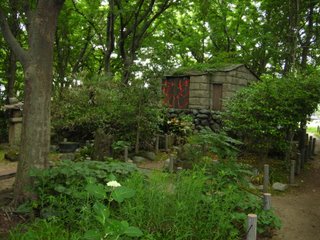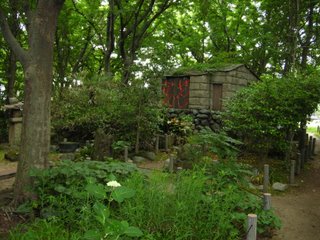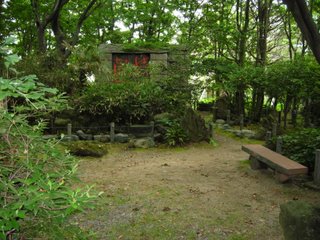The Japanese language is bestrewn with the corpses of terms unable to resist the onslaught of Western loan words. In this space I shall post belated obituary notices of obsolete Japanese. The index will be updated periodically. Contributions are welcome.
辻自動車: (tsujijidousha) literally, "self-moving vehicle at the street corner", better known as taxi
百貨店:(hyakkaten) "shop of a hundred items", now called depaato, from department store
庭球:(teikyuu) "garden ball", now tennis
玉突き(tamatsuki) "the striking of balls", or billiards
白墨(hakuboku) "white India ink", or chalk
受像機(juzoki) "image receiving machine", or television
写真機(shashinki) "reality-copying device", or camera
羽球(ukyuu) "feather ball", or badminton
受話器(juwaki) "conversation-receiving apparatus", or head-phones
配球(haikyuu) the game of "delivering the ball", or volleyball
Tuesday, December 26, 2006
Sunday, December 24, 2006
Tetrapods at Work
A Tetrapod Farm

 Tetrapods are a Showa Era innovation and emblematize the natural catastrophe that is one characteristic of Japan's encounter with the Western World. Donald Richie, longtime expat and insightful translator of Japanese culture, laments the suspension of the "truce" which formerly existed between Japan and Mother Nature. In other words, whereas until the early 20th century the Japanese implicitly acknowledged limitations on their ability-and the desirability thereof-to alter or manipulate Nature, modern Japan admits no such restrictions. For instance, coastal areas subject to extremes of violent weather and which, in times bygone, were wisely deemed off-limits to development, are now depressing (and expensive) examples of capitalism run amok. To protect private property and the infrastructure that makes it possible(as well as to subsidize the local cement people), erosion control measures, chiefly in the form of tetrapods, have been implemented along vast stretches of Japan's coastline. But not even the mighty tetrapod can protect coastal roads and other beachfront development from typhoon-generated storm surge or tidal waves produced by boreal winds, for every year construction crews rush to repair damage inflicted by inclement weather. With the fate of the Earth's ecosystem hanging in the balance, let us hope that Japan returns to her roots and lights the world's way forward to a sustainable co-existence with all of creation.
Tetrapods are a Showa Era innovation and emblematize the natural catastrophe that is one characteristic of Japan's encounter with the Western World. Donald Richie, longtime expat and insightful translator of Japanese culture, laments the suspension of the "truce" which formerly existed between Japan and Mother Nature. In other words, whereas until the early 20th century the Japanese implicitly acknowledged limitations on their ability-and the desirability thereof-to alter or manipulate Nature, modern Japan admits no such restrictions. For instance, coastal areas subject to extremes of violent weather and which, in times bygone, were wisely deemed off-limits to development, are now depressing (and expensive) examples of capitalism run amok. To protect private property and the infrastructure that makes it possible(as well as to subsidize the local cement people), erosion control measures, chiefly in the form of tetrapods, have been implemented along vast stretches of Japan's coastline. But not even the mighty tetrapod can protect coastal roads and other beachfront development from typhoon-generated storm surge or tidal waves produced by boreal winds, for every year construction crews rush to repair damage inflicted by inclement weather. With the fate of the Earth's ecosystem hanging in the balance, let us hope that Japan returns to her roots and lights the world's way forward to a sustainable co-existence with all of creation.
Wednesday, December 20, 2006
Basho and Sora in Niigata



Haiku master Basho and travelling companion Sora left Yamagata for Niigata in early August, 1689. Crossing the Nezu Barrier into Echigo, as Niigata was then known, the two made their way to Kaga Province (Ishikawa Prefecture) via Murakami(8/13), Tsuiji(8/15), Niigata City(8/16), Izumozaki(8/18), Naoetsu(8/20), Takada(8/22), Noh (8/25), and Ichiburi (8/26). The approximate distances (in kilometers) between towns are as follows: Murakami-Tsuiji, 30K; Tsuiji-Niigata, 40K; Niigata-Izumozaki, 60K; Izumozaki-Naoetsu, 30K; Naoetsu-Takada, 10k; Takada-Noh, 15K; Noh-Ichiburi, 30K. Crossing the Ichiburi Barrier, Basho and Sora entered Toyama. Kaga was three days distant.
Tuesday, December 19, 2006
Basho-do Photos



The following photos show Niigata City's Basho Monument, a site commemorating haiku founder Matsuo Basho's visit to the city on 16 August, 1689. During their 奥の細道 pilgrimage, Basho and travelling companion Sora spent little time in Niigata, regarding Echigo Province (as Niigata was then known) as an unavoidable evil to be endured. During the three weeks Basho and Sora followed the treacherous "North Country Road" along the Japan Sea coast, only one poem was composed. On August 18, Basho wrote the following poem at the small port of Izumozaki.
O'er wild ocean spray/ All the way to Sado Isle/ Spreads the Milky Way!
Monday, December 18, 2006
Basho in Niigata



Matsuo Basho, father of the verse form haiku, set off from Edo (Tokyo) in May of 1689 on a pilgrimage to Japan's northern provinces. Accompanied by his disciple Sora, the two covered some 2400 kilometers, mostly on foot, during the ensuing five months. Their peregrinations took them along the Sea of Japan coast later that year, in August . Following the Hokuriku Road southwest from Yamagata Prefecture, the poets made few stops-and penned even fewer haiku- while in Echigo Province, as Niigata was then known. Nevertheless, Basho composed a fine poem in the village of Izumozaki, a small port sixty-odd kilometers from Niigata City. The following translation is by Dorothy Britton.
O'er wild ocean spray/ All the way to Sado Isle/ Spreads the Milky Way!
Though Niigata City itself cannot boast of having inspired the master's muse, the city honors Basho with a fine monument, the Basho-do, located on a promontory overlooking the sea. In clear weather, 佐渡ヶ島, the Sado Isle of Basho's poem, is clearly visible 65 kilometers away.
The photos show Basho-do and its setting in a copse of trees, as well as a nearby view of the Japan Sea. Incidentally, the Basho Memorial is in the vicinity of the site of Megumi Yokota's abduction.
Saturday, December 09, 2006
The Remains of the School Day



A brief discussion of extra-curricular activities shall complete my description of a typical day at Kido JHS. As was remarked in a previous post, club activities constitute a central part of the middle school experience in Japan. In fact, club participation at the 12 Niigata City junior high schools at which I have so far taught has averaged close to 90% of total student enrollment. Kido JHS is no exception. There is a club for nearly every interest and temperament, as the following enumeration demonstrates. For boys as well as girls, there are the art, band, track and field, kendo, basketball, science, and computer clubs. Clubs exclusively for boys include soccer, baseball, table tennis, and soft tennis. For girls, there is volleyball, softball, badminton, or rhythmic gymnastics. Students who participate in extra-curricular activities choose a single club and remain there- or, to paraphrase Mark Twain, put their eggs in a single basket, and proceed to watch it. In Japan, there are no school sports seasons, properly speaking. Therefore, students practice with their club year-round. At Kido JHS, clubs meet until 5:00 PM in winter, but from late spring to late fall, practice ends at 6:00. One result of the emphasis on a single club is that the art and band clubs are, on average, far superior to their American counterparts. Alternatively, I often meet athletically talented students who are highly accomplished in their club sport but who, owing to the limitations of the Japanese system , are remarkably inept at other athletic activities. Kido's gym is shown above. Note the absence of bleachers, which is typical of Japanese school gyms. Spectators use the narrow, second story gallery. One of Kido's two soft tennis courts is also pictured. Soft tennis is a form of tennis that originated in Japan. It is played on a sanded court, with racquets that are slightly smaller than the ordinary. Moreover, the racquets are strung at a tension of about 30 lbs., somewhat less than that for standard racquets. The ball used in soft tennis is approximately the size of a regular ball, minus the felt. Lastly, the net is raised a few inches higher than for the hard-court game. Soft tennis is a rather forgiving form of the sport, a direct result of the string tension, as well as the cushiony quality of the ball. Simply put, a mis-hit will often land in play. While soft tennis is easier to learn than the hard court style, one wonders whether the lack of opportunities for young Japanese to play hard court tennis doesn't partly account for the dearth of Japanese on the pro circuit.
Saturday, December 02, 2006
The School Day- After Lunch

Lunchtime and the noon recess have ended, and the bell announcing the start of fifth period sounds. Three days a week, the fifth class is a followed by a sixth. Five minutes after the final class ends, school cleaning begins. The students clean the school themselves. They are assigned work stations, and in brigades of 5 to 8 students, proceed to sweep, scrub, and otherwise tidy up the school. Excepting the restrooms, which are cleaned at Kido JHS by a professional cleaning firm; the equipment storage rooms, which are seldom cleaned; and the teachers' locker rooms, no corner of the school remains untouched. At some schools (Kido is not among them), the students pick up litter that has collected on the school grounds. All of this is done to the accompaniment of music. A digression is called for here. The jingle played over the PA system during cleaning time is of a genre that would seem to have been created for the express purpose of stimulating the students into a sort of cleaning frenzy. Fast paced and instrumental, the tune is not something one would hear on the radio, or find on a compilation at the local CD shop, or hear anywhere outside of the particular school at which it is played. I have now taught at 12 junior high schools in Niigata City, and no two have played the same cleaning tune. Consider that, and ponder the tremendous business opportunities that await the producers of such recordings. Their cleaning done, the brigades hold short meetings with their supervising teacher to evaluate work performance. After that, it's back to the classroom for the afternoon homeroom meeting. This concluded, it is time for club activities, to participate in which is the primary reason some students attend school at all. A final note: you may be wondering whether there are no janitors at Japanese schools. Janitors there are none, but rather handymen, who maintain the school grounds and make simple repairs. They tend to keep to themselves, being provided their own comfortable room just inside the entrance to the school.
Saturday, November 25, 2006
Yorii Beach and Megumi Yokota



This sign, posted by the Niigata Prefectural Police at the entrance to Gokoku Shrine, instructs anyone with information regarding the kidnapping of Megumi Yokota to notify the authorities. Abducted by North Korean agents on her way home from school, early in the evening of November 15, 1977, Megumi is believed by many Japanese to be alive in North Korea. While admitting that its agents carried out the kidnapping, North Korea claims that Ms. Yokota succumbed to illness many years ago. To substantiate this claim, North Korea has provided amateurishly forged "evidence", at the same time asserting that Ms. Yokota's remains were washed away by floods. It is believed that the agents landed on Yorii Beach, their submarine lying some distance offshore. Furthermore, it is thought that their instructions were to abduct whomsoever should come along first that November evening. Megumi, who had moved to Niigata City with her family a few months before, lived not far from the beach and would have been one of the few pedestrians about in the area where she was last seen, on her way home from school badminton practice after 5:00. As the sun sets at 4:30 in mid-November, the abductors would have been emboldened by the cover of darkness. Megumi Yokota is not the only Japanese known to have been abducted by North Korea- officially, there are 17 others-, but her case receives the most publicity, due in part to the tireless efforts of her parents and supporters. A recently released, critically acclaimed U.S. documentary about Ms. Yokota's abduction may prompt the Japanese public to demand tougher sanctions against the North Korean regime, unless there is progress toward resolving all outstanding abduction cases.
Monday, November 13, 2006
A Few Points of Interest




I shall take a brief recess from my description of a typical day at Kido Junior High School to introduce a few points of interest in Niigata City. After being designated one of Japan's five treaty ports, in 1868, Niigata City embarked on an ambitious program to modernize itself in anticipation of its first foreign visitors. A Custom House was built to facilitate foreign commerce. This lovely structure, in use until the 1970's, is the only one of the original five remaining today. Located near the mouth of the Shinano River, Japan's longest waterway, the Old Custom House is one of three facilities comprising the Historical Niigata Complex, or Minatopia. Additional improvements included the building and widening of roads, as well as the cleaning of the city's extensive network of canals. The canals connected to the Shinano River, permitting the delivery of riverborne freight to the city center. Once lending Niigata a distinctive character and charm, the canals have long since been filled in and paved over. The changes Niigata underwent were not limited to infrastructure or administration, however. A delegation from the Imperial government, touring Niigata City to observe first-hand the progress of its "internationalization", concluded that the city would not be properly "finished" without a large public park. Thus, in 1873, Hakusan Park was established as one of the first public parks in all of Japan. The orange gate, or torii, stands at the downtown entrance to Hakusan Shrine and Park. The etymology of the term torii is somewhat uncertain, but the 2 Chinese characters comprising the word mean, literally, "birds' roost". A traditional Shinto rite, now fallen into disuse, summoned the devout believer to morning prayer, a reverential salute to the rising sun. Shinto shrines therefore raised fowl for the purpose of announcing the coming of dawn, and of rousing the priests from their slumber. From their lofty perch atop the shrine gate, the cocks would herald the day's approach.
Friday, November 10, 2006
School Lunch, Second Course

The previously posted comments regarding school lunch describe a school nutrition program introduced only a few years ago. When I began teaching in Niigata City six years ago, fewer than five of the city's 31 public junior high schools provided school lunch. Instead, parents (usually mothers) prepared a lunch box for their children to take to school. However, as the number of parents either unable or unwilling to prepare a lunch increased, and as the number of students eating junk food rather than a nutritious meal grew, school authorities developed the current lunch program. Schools were required to constuct lunchrooms and to purchase ordering machines such as the one shown above- all at considerable expense.
Wednesday, November 08, 2006
School Lunch




The 50 min. lunch period at Kido Junior High starts at 12:40. When the bell announcing the end of 4th. period sounds, the students return to their homerooms. If they are scheduled to eat in the school lunchroom , the students proceed downstairs with their homeroom classmates, meal ticket in hand. Alternatively, if the students are eating box lunches in their homeroom, they make their way to the box lunch serving-line located in one of the ground floor hallways.
Lunch for any given day must be ordered no less than a week in advance. Each student who eats school lunch is issued a bar coded meal card. The card permits the student to order as many meals as his account balance permits. Lunch costs 260 yen, or about $2.25. There are 4 menu items each day: 2 box lunches, and 2 meal choices available only to students eating in the lunchroom that day.
The color menu at right shows the box lunch selections for the month of October. Caloric information is given as well. The menu is taped to the side of the computer terminal used to place meal orders. For a better view, see photo, above right.
Friday, September 08, 2006


The contributions of the aforementioned Kobo Daishi to Japanese culture probably cannot be overstated. In addition to founding one of the four major Buddhist sects, "Great Teacher" Kobo is also credited with introducing tea to Japan, as well as with devising the Japanese syllabary known as hiragana. He was a famed calligrapher, and numerous legends relate almost supernatural feats of brushwork. I will paraphrase one such representative tale. The Emperor of Japan, desirous that a tablet destined for a certain Kyoto temple be decorated by the brush of Kobo, despatched a messenger bearing the tablet to the great priest's abode. A swollen and impassable river blocking the way, the worried messenger was standing on the bank, concerned lest he forfeit the Emperor's trust-and perhaps his own life- when who but Kobo himself should appear on the opposite bank. Being made to understand what was required, Kobo asked that the tablet be raised overhead, whereupon he traced the characters in the air with his brush. No sooner was he done than each of the characters miraculously appeared on the tablet, held aloft by the messenger on the farther bank. The accompanying photos show a statue of Kobo Daishi, flanked by candelabra of gilt lotus blossoms and leaves, in a shrine at Shijiin Temple.
The photo accompanying the introductory remarks shows a temple of the Shingon sect of Japanese Buddhism. Shingon was founded in the early 9th century by Kobo Daishi, also known as Kukai. Today, Shingon and its 47 sub-sects maintain some 12,000 temples and number 12,000,000 adherents. The inscribed pillar beside the gate informs us that Shijiin, as the temple is named, is one of 21 such temples in the Echigo region, an ancient province that comprises Niigata Prefecture. While there are probably hundreds of Shingon temples in Echigo, I suspect that Shijiin Temple (as well as the other 20) claims its special status by virtue of its impressive size, as well as from its collection of statuettes representing the 88 temples of the famous Shikoku pilgrimage. Each statue is inscribed with a number, 1-88, which indicates the order in which its corresponding temple appears along the pilgrimage route. Furthermore, the Buddhist deity or saint associated with each temple is carved on the statue in relief. Each year thousands of Buddhist faithful and non-believers alike undertake to complete a stage, or some few stages, of the pilgrimage route. The especially devout or determined may don the traditional white robe of a Buddhist pilgrim and, with the pilgrim's staff for support, set off on foot. Others dispense with the garb and staff, opting to save time and shoe leather by traveling on two wheels. For those of infirm body or purpose, there are charter bus tours available.
Introductory

This blog was begun with a dual purpose: to provide myself a forum in which to articulate my impressions and broaden my understanding of Japan, the country I have called home for eight years; additionally, I hope to offer the viewer illuminating pictorial glimpses of Japanese culture and daily life, as well as insights into a Japan that is typically bypassed by the standard travel itinerary and tourist guide.
Subscribe to:
Posts (Atom)












